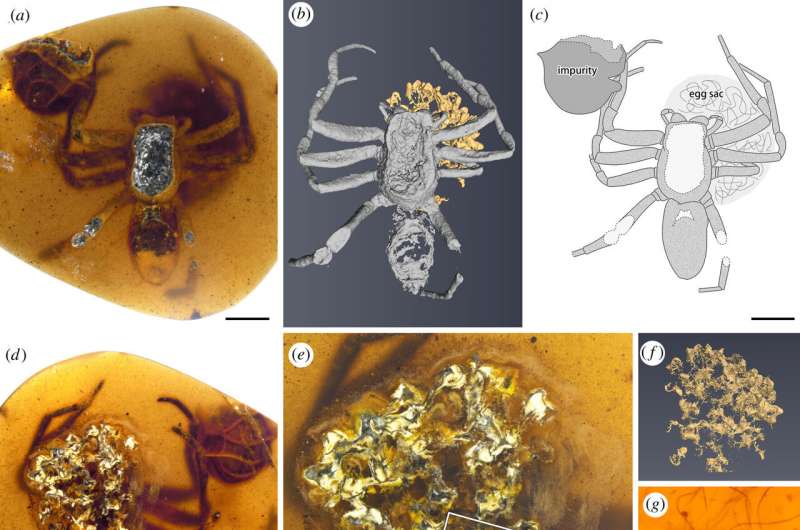September 15, 2021 report
Ancient spider mom preserved in amber found to be protecting her young

A trio of researchers with Capital Normal University in China has found evidence of a mother spider protecting her young in an amber sample dated back to 99 million years ago. In their paper published in Proceedings of the Royal Society B, Xiangbo Guo, Paul Selden and Dong Rend describe where the sample was found and what they learned about the spider it contains.
Many modern spider species have been found to take measures to ensure the survival of their offspring—females have been seen crouching to cover hatchlings, for example, and producing silk to tie and hold eggs closely together. In this new effort, the researchers have found evidence of a mother spider from the mid-Cretaceous exhibiting the same behavior.
The researchers found four chunks of amber that had been extracted from a mine in Myanmar that contained entombed spiders. In one of the chunks, they found an adult female with a bit of her egg sac still intact underneath her body. Study of the facial features showed that the spider was a member of the extinct Lagonomegopidae family. The researchers also noted that the female was in a stance very similar to that of modern female spiders who are engaged in protecting their eggs from predators. A closer look showed the female had also used her own silk to tie the eggs together. Notably, some scientists have suggested that silk production in spiders began with attempts to tie eggs together, and once it was established, they began using it for other purposes, such as building webs.
The three other chunks of amber contained baby spiders and spider thread. One also had what appeared to be an arthropod leg and a wasp. The researchers suggest it is likely that each chunk of amber holds related spiderlings—all of which have been identified as members of the Lagonomegopidae family. The researchers note that both the adult female and the groups of spiderlings all had large eyes, which suggests they were free-range hunters rather than web builders. They also note that one of the chunks contains bits of material suggesting the spiderlings had recently exited a nest.
More information: Xiangbo Guo et al, Maternal care in Mid-Cretaceous lagonomegopid spiders, Proceedings of the Royal Society B: Biological Sciences (2021). DOI: 10.1098/rspb.2021.1279
Journal information: Proceedings of the Royal Society B
© 2021 Science X Network




















